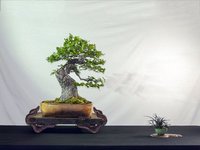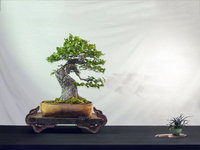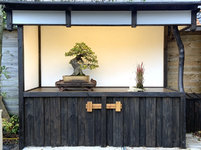Ruddigger
Omono
Thanks! What do you mean with Bjorn vibes?
The styling of it, reminds me of his work. Perfect.
Thanks! What do you mean with Bjorn vibes?
Wow Thanks! i made it all by myself, including the stand he’s standing onThe styling of it, reminds me of his work. Perfect.
Almost finished! Just Some detailwork!
View attachment 388092
Yes, the panels are Made from HPL, which doesn’t degradeVery nice work! What are the white panels made from? Will they be able to withstand the weather without degrading?
Thanks! I am proud of it all for sure!WOW!
That display came out looking sweet!
Beautifully done, my congratulation's to you!
Especially that unique and awesome stand that you created for the larger bonsai tree!
You should be proud of yourself for such a fine job well done and it's presentation.
Thank you! ....Just be prepared and have the right tools and you are halfwayAmazing....I wish I have 1/10 of your skill and vision.


Thanks Micheal, I really appreciate your constructive feedback.Hello Marco,
Bravo for this wonderful realization of your tokonoma.
Without any destructive criticism, you should turn the jita (small wooden plate) under the shitakusa in the other direction.
View attachment 408471
View attachment 408472
You have beautiful trees, feel free to occupy more space in the tokonoma.
This is only my opinion.
Congratulations again.
Michel
Hi Toche, interesting! I would like to learn more about this, and exposition of bonsai in general....can you explain further what you mean with your last sentence? What does that have to do with the Jita? (Is a Jita always made of wood? If so, then this is not a Jita, because I made it from concrete)Hello Marco,
The shape of your Jita (generic term) gives it a meaning, a direction.
Depending on its placement, it further accentuates the meaning of the shitakusa (Ophiopogon).

Thank you so much for you compliments Michel!Marco,
I risk to give you a strange answer.
Let me explain, I studied traditional bonsai, that is to say bonsai as it was exhibited in the past.
My old Japanese Master used to say this: "I teach you traditional bonsai, so when we work on the trees together, we follow my teaching, but at home, it will be according to your sensitivity."
He added, "If you open a catalog of the great Japanese exhibitions or visit them, you will see that things have changed over time and it's not quite the way I teach it."
Today, after all these years of training, I remain faithful to his teaching.
I spent hours and hours doing tree presentations with him.
He was very strict, for example, when I did a presentation in a tokonoma, he required me to wear white gloves because the tokonoma is a sacred place. (It was the place of the lord in the old days.)
Along with his rigor, he was always positive and incredibly open-minded.
He never gave destructive criticism of my presentations or my work on trees and kept no secrets from me.
He is a person I deeply admire and respect.
He taught me the rules (I hate this word "rule") of styles and presentation in tokonoma. He knew how to explain the logical or sometimes historical reasons so that it was easy not to forget them. For me, he is a real master.
I am 66 years old and I often laugh and say that I would like to be like him when I grow up.
Now let's talk about your tokonoma and your presentations.
Basically, it doesn't match what I was taught, BUT, that doesn't mean it's ugly or bad.
I think my previous few posts prove to you that I'm not criticizing what you're doing, quite the opposite. It's just different and you have the great merit of innovating. So it's interesting.
You use wonderfully materials like concrete to reproduce or give the illusion of rail or jita attachments, we don't use these materials in traditional bonsai, but you innovate and that's what makes it interesting.
After that, it's up to everyone to appreciate or not.
In the words of my dear master: "It's up to your sensibility."
All this to tell you that I could only give you an opinion about your tree, your accent plant, the presentation and the tokonoma according to the traditional bonsai.
Best regards
Michel
